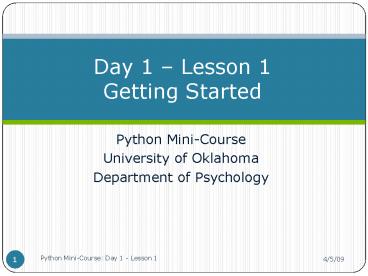Python Mini-Course - PowerPoint PPT Presentation
Title:
Python Mini-Course
Description:
Getting Started Python Mini-Course University of Oklahoma Department of Psychology Python Mini-Course: Day 1 - Lesson 1 4/5/09 * Lesson objectives Describe what ... – PowerPoint PPT presentation
Number of Views:190
Avg rating:3.0/5.0
Title: Python Mini-Course
1
Day 1 Lesson 1Getting Started
- Python Mini-Course
- University of Oklahoma
- Department of Psychology
2
Lesson objectives
- Describe what Python is
- Understand how Python can be used in behavioral
science - Install Python and add-ins
3
What is Python?
- General purpose computer programming language
- Has math and science add-ins
- Has GUI add-ins
- Multi-platform
- Same program can run on MS Windows, Mac OS X,
Linux, etc.
4
What can I do with Python?
- Write programs to run experiments
- Example Trivia Lag Expt
- Computational modeling
- Example fSAMpy
- Statistical analyses
- Example bootstrapping
5
What can I do with Python?
- Data processing and analysis
- PyParse (Kahana lab)
- fMRI (Waisman Brain Imaging Lab)
- Just about anything else you can think of
- Games, graphics, audio apps, even cell phone
apps(http//www.awaretek.com/pymo.html)
6
How does Python compare
- Other languages (C, C, Visual Basic, Java,
etc.) - Python is easier to learn
- Python is just as powerful
- Python is NOT as widely used
7
How does Python compare
- Scientific computing packages (Matlab and
Mathematica) - Statistical packages (SAS, SPSS, R, etc.)
8
Python isFREE
9
How to get and install Python
- Were going to install several components
- Python the main language
- wxPython for building and running GUIs
- NumPy and SciPy for numeric and scientific
computing - SPE (Stanis Python Editor)
10
Installing Python
- www.python.org/download/releases/2.5.4
- Find your platform (Windows or MacOS X) and click
on the download link - Save the file to your hard drive
- Run the installer program
11
Installing wxPython
- http//www.wxpython.org/download.php
- Windows
- download win32-unicode
- MacOS X
- download osx-unicode
- Save the install file, then run it
12
Installing NumPy
- http//numpy.scipy.org/
- Click on the download link
- Download numpy-1.3.0rc2 for your platform and
Python version - Run the install file
13
Installing SciPy
- http//sourceforge.net/project/showfiles.php?group
_id27747 - Click on the download link
- Download scipy0.7.0 for your platform and Python
version - Run the install file
14
Installing SPE
- For MS Windows
- http//prdownload.berlios.de/python/SPE-0.8.4.c-wx
2.6.1.0-no_setup.zip - Unzip it to somewhere you will remember (e.g.,
Program Files) but dont rename the folder
anything other than _spe. - Go inside the _spe directory you just created and
double click SPE.py
15
Installing SPE
- For Mac OS X
- http//olczyk.krzysztof.googlepages.com/SPE.dmg
- Save the file, mount the disk image, and follow
the instructions
16
Python resources
- www.python.org
- http//python.org/doc/2.5/tut/tut.html
- www.scipy.org
- http//numpy.scipy.org































